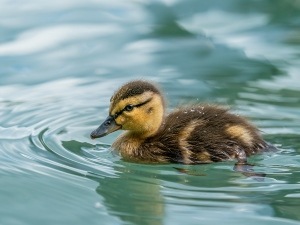
Hatching ducklings is not always smooth sailing. If you’re lucky, these birds will hatch and will have no problems during hatching, but you may not always be so lucky.
If your bird hatched with organs sticking out of its abdomen then the bird may have an umbilical hernia
Table of Contents
Duckling umbilical hernia:
If you flip a duckling on its back, the only opening that you should see is the bird’s vent.
A hernia describes a situation where organs protrude through the wall cavity that is meant to be containing it, ducklings can suffer from this condition, and it’s called an umbilical hernia.
What is an umbilical hernia?
The term umbilical hernia describes the situation where parts of the inside of the bird’s body, at the abdomen, protrude to the outside of the bird’s body.
A duckling’s lining, fat, yolk, or organs can be what pass through the opening at the bird’s abdomen.
This is a very common condition that usually develops in premature ducklings.
Ducklings develop in eggs with the yolk on the outside of their bodies. The bird will absorb the yolk towards the end of incubation, just when it is about to hatch.
If the bird hatches before it has time to absorb the yolk, then the yolk, or other organs, will be outside of the body when the bird hatches resulting in an umbilical hernia.
What to do:
An umbilical hernia isn’t a death sentence, the bird can survive and won’t develop an infection if the hernia is dealt with properly. This is what to do with a bird suffering from this condition:
Isolate the bird:
Isolating the bird will allow it to recover on its own without the stress of having other ducklings around it. The isolation will also keep the other ducklings from pecking at the bird’s hernia out of curiosity.
Create an enclosure for the bird using a cardboard box. Do not use bedding in the bird’s enclosure but keep the bird on something comfortable like a soft towel.
The bird will be fine once the abdomen is closed off.
Keep the yolk sac intact:
The umbilical hernia may or may not have a yolk sac attached, if it does have a yolk sac attached make sure that the yolk sac doesn’t break open.
The yolk sac supplies the bird with nutrients during the first 24 hours of the bird’s life.
Try to keep the bird from moving around too much. Do this by keeping the enclosure small and keeping food and water sources close to the bird.
If the umbilical hernia breaks then the bird may get septicemia, this is where bacteria get into the opening and quickly multiply, this can quickly be fatal to the bird.
Make sure that you, and the duck, don’t pull the hernia out, pulling it can cause the bird’s intestines to come out.
Cleaning:
Keeping the area clean is a must, these little birds can become infected via the hernia very easily, and an infection can kill the bird.
Clean the hernia using betadine. You can also soak the hernia in a solution of chlorhexidine wound wash diluted in water. Pour the solution into a container and let the bird soak in it.
Make sure that the solution covers the bird’s whole hernia. Soak the hernia twice a day then proceed to apply silver sulfadiazine to the wound to keep an infection from developing.
Provide warmth:
Just as with any other duckling, your duckling will need to be kept warm once it hatches. Keep the bird warm by installing a heat lamp in its enclosure to provide warmth.
Push the hernia back in:
If your bird’s protrusion is quite large you may need to push it back in. You’d need antibacterial soap, a soft pad, liquid antiseptic, boiled water, rubbing alcohol, a q-tip, KY jelly, and super glue, or a plaster, to do this.
Start off by washing your hands with warm water and antibacterial soap for at least one minute.
If the protrusion has dirt on it, remove the dirt using a soft wet pad soaked in a solution of boiled, then cooled, water and a few drops of liquid antiseptic
Sterilize your work surface with rubbing alcohol. Put the bird on the surface and then swab the area around the navel using rubbing alcohol. Do not swab directly on the bird’s protrusion, this will be very painful for the bird.
Push the protrusion into the bird’s body using a q-tip or your finger (make sure your fingernails are short and clean before doing this, lubricate your finger with a sterile gel like KY jelly).
Seal the area using a small drop of super glue or plaster it without covering the bird’s vent.
Visiting the vet:
Taking your duckling to the vet is also a good option. The vet will be able to accurately assess what is going on with the bird and treat it. Your vet may remove the hernia and tie the remaining portion off
If you enjoyed this article then you may also be interested in other duck related articles. Here are some articles that you may be interested in: Duckling Breathing Heavy, Why Do Ducks Kick Eggs Out Of A Nest, Duck Wheezing, Internally Pipping Duck Eggs


